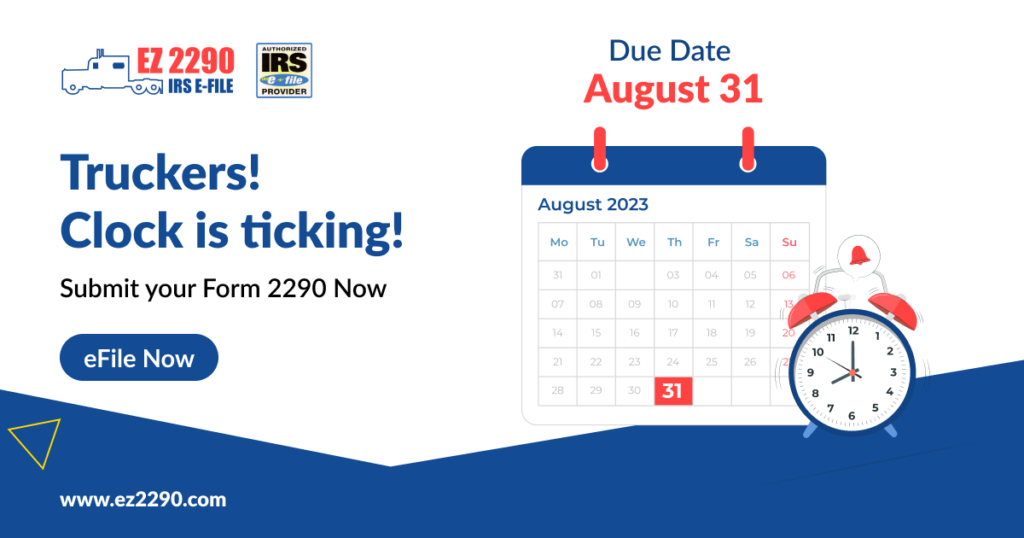Form 2290, commonly known as the HVUT Form 2290, is a crucial document for reporting Heavy Vehicle Use Taxes (HVUT) paid on taxable vehicles with a gross weight of 55,000 pounds or more. This guide will walk you through the intricacies of Form 2290, including its due date, filing requirements, and essential information you need to know. Whether you’re a trucking business owner or an individual vehicle operator, understanding Form 2290 is paramount to staying compliant with IRS regulations.

When is the Form 2290 due date?
The due date for Form 2290 depends on the first used month of the taxable vehicle. Typically, the tax period begins on July 1st and concludes on the following year’s June 30th. If your vehicle was on the road by July, the Form 2290 due date is August 31st. This deadline aligns with the most common practice of putting vehicles into operation at the start of the tax period.
For those who put their vehicles on the road in July, Form 2290 due date is of particular importance. Filing by August 31st ensures compliance and avoids penalties. Your vehicle’s operation start date dictates this deadline, making timely filing crucial.
Vehicles that have their first use month other than July or newly purchased vehicles have a different Form 2290 due date. In this case, the filing deadline is the last day of the month following the month of the vehicle’s first use. For example, if your vehicle was first used in November, your Form 2290 due date will be December 31st.
| If the vehicle is first used during | File IRS Form 2290 and make your payment by |
| July 2023 | August 31, 2023 |
| August 2023 | October 02, 2023 |
| September 2023 | October 31, 2023 |
| October 2023 | November 30, 2023 |
| November 2023 | January 2, 2024 |
| December 2023 | January 31, 2024 |
| January 2024 | February 29, 2024 |
| February 2024 | April 01, 2024 |
| March 2024 | April 30, 2024 |
| April 2024 | May 31, 2024 |
| May 2023 | July 01, 2024 |
| June 2023 | July 31, 2024 |
Related Article: Meeting the Deadline: A Comprehensive Guide to Last-Minute eFiling for IRS Form 2290
Documents/ Information Required to File Form 2290
Filing Form 2290 requires specific information to accurately report your HVUT payments. Here’s what you need:
For Businesses:
- Employer Identification Number (EIN)
- Business Name
- Address
For Vehicles:
- Fleet Unit Number (FUN)
- Vehicle Identification Number (VIN)
- Taxable Gross Weight
IRS Payment Methods: Choose What Suits You
- Credit/Debit Card: Pay using your credit or debit card. This method offers convenience and speed in completing your payment.
- Direct Debit (EFW): Opt for Electronic Funds Withdrawal (EFW) to have the payment directly debited from your bank account.
- EFTPS (Electronic Federal Tax Payment System): If you prefer using EFTPS, ensure you’ve enrolled in the system to facilitate the HVUT payment.
- Check/Money Order: The traditional method of paying by check or money order is also available.
Related Article: How To File IRS Form 2290 Online For Tax Year 2023-24 (Step-by-step guide)
eFile Form 2290 before the Deadline
To make things easier and quicker, the IRS suggests using electronic filing (eFiling) for Form 2290. This way, you can get your Schedule 1 faster. Because of the pandemic, there’s a backlog at IRS offices, so they’re encouraging truckers to choose eFiling.
With platforms like EZ2290, you can finish filling out Form 2290 in just a few minutes. And the best part is, you’ll get your Schedule 1 right away.
EZ2290 is the IRS-approved Form 2290 eFile service provider.
Need assistance? Reach out to us at [email protected]




